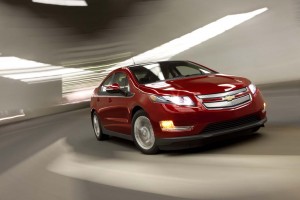
NHTSA has now launched a formal investigation after an additional fire in a Chevy Volt battery pack it was crash-testing.
Already concerned about a battery fire that followed the spring crash test of a Chevrolet Volt, federal safety regulators have opened a new investigation as the result of additional fires involving Volt’s lithium-ion batteries.
Company officials have already blamed the initial incident on a failure to follow proper procedures following the crash test by the National Highway Traffic Safety Administration, and they contend the Volt is safe despite the latest fires. But the new study could create a serious problem for the automaker as it gets ready to push for a six-fold increase in sales of the plug-in hybrid next year.
In a statement, GM said it has “worked closely” with the NHTSA and wasn’t surprised by the news the agency would launch a formal investigation. But the maker also declared the volt “is safe and does not present undue risk as part of normal operation or immediately after a severe crash.”
Separately, the maker has said it has developed a new system that should be used after a serious crash to “de-energize” or discharge the battery. It plans to distribute the new technology to first responders and others who might have to deal with or store a Volt after a crash starting in early 2012.
NHTSA was originally alerted to a potential problem with the Volt battery pack when one of the battery cars caught fire three weeks after being subjected to a side impact crash test at a Wisconsin facility last May. The first was severe enough to damage several other vehicles nearby the Chevrolet Volt.
When that incident came to light, early this month, GM officials initially told TheDetroitBureau.com that it was the result of NHTSA failing to follow proper procedures after a battery pack was damaged. The safety agency did drain the Volt’s gas tank, as routine calls for, but it left the wreck with a battery that retained at least a partial charge. After several weeks being exposed to cold weather, GM officials explained, the normally inert liquid coolant used in the T-shaped battery pack underwent a chemical change that shorted out the lithium-ion cells, leading to a fire.
That explanation might have headed off an investigation were it not for additional problems with another Volt battery pack that NHTSA testers were following. It initially showed a spike in temperature and then caught fire on November 17th. A third, recently crash-tested battery pack sparked and smoked.
Those tests were conducted at a separate facility NHTSA uses in Virginia. They were part of an effort by the safety agency to test the Volt’s battery packs in an effort to replicate what had happened in May.
Though a Volt was involved in a garage fire – which authorities did not believe was caused by the vehicle – there have so far been no reports of fires attributable to crashes or other incidents involving the Chevy plug-in.
In a statement following news of the latest fires, the automaker said, “Since July, GM has implemented a post-crash protocol that includes the depowering of the battery after a severe crash, returning the battery to a safe and low-powered state.”
It is unclear whether that new protocol was followed as part of the latest battery crash tests by NHTSA.
NHTSA isn’t the only government agency taking a close look at lithium-ion batteries. There have been millions of laptop computers and other consumer electronic devices made by such major manufacturers as Apple, Dell and Sony recalled due to reports of fires – or the potential risk of such problems – over the last five years.
The batteries can burn at temperatures well in excess of 1,000 degrees.
The Federal Aviation Agency has restricted the transport of LIon batteries in cargo holds and a fire in a UPS jet was believed responsible for a fatal crash near Dubai in 2010.
But lithium technology is becoming increasingly widespread, in devices ranging from portable drills to battery cars like the Volt and the Nissan Leaf.
Despite the possibility that the new investigation might eventually lead to a recall of the Volt, the safety agency states that, “NHTSA continues to believe that electric vehicles have incredible potential to save consumers money at the pump, help protect the environment, create jobs and strengthen national security by reducing our dependence on oil.”
GM has seen a steady ramp-up in sales of the Chevy Volt in recent months, volumes topping 1,100 in October, though the plug-in hybrid is likely to miss its target of 10,000 units this year. Nonetheless, the automaker is pushing for an even more aggressive goal for 2012. It hopes to build 60,000 of the vehicles –including the similar Opel Ampera – of which 45,000 would be earmarked for the U.S., the rest for Europe, China and other parts of the world.
